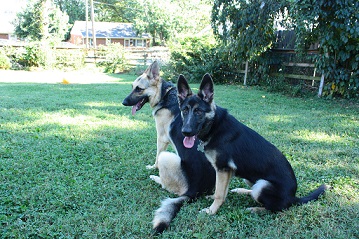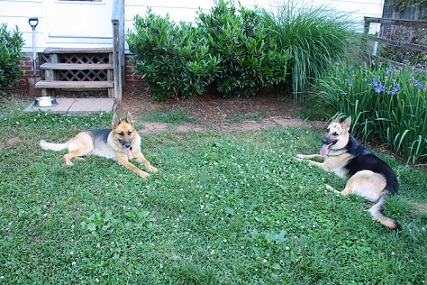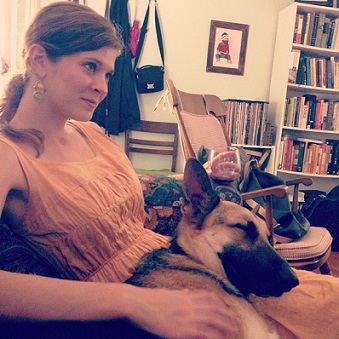One of the most rewarding ways to help a dog in need is to open up your home to a shelter or rescue dog while she waits to be adopted.
I follow the blog Doggerel by Abby Farson Pratt where she often writes about her experience fostering German shepherd dogs.
I asked Abby if she would be willing to answer some questions on what it’s like to foster a dog, and she said yes! Abby and her husband recently adopted their most recent foster dog, Eden.
What to expect if you foster a dog
That Mutt: Why did you decide to start fostering dogs?
Abby Farson Pratt: We fell in love with the dog rescue after we adopted our first dog, Pyrrha, from Southeast German Shepherd Rescue (SGSR).
Pyrrha (pronounced “peer-ah”) is a sweet but anxious dog with a lot of fear issues, but she is her happiest in the company of other dogs.
We weren’t quite at a stage of being ready to adopt a second dog, so we thought that fostering German shepherds from SGSR would be a great way for us to give Pyrrha some much-needed canine company and to help dogs get ready for their forever homes.

TM: What were some of your initial concerns about fostering before you started?
AFP: I was always nervous about how Pyrrha and the foster dog would get along; most of the dogs came to us from shelters with very little background information.
Thankfully, however, we never had an issue with Pyrrha and a foster. We always took first introductions very slowly and carefully, and I think that helped.
I was also nervous about how we’d manage two big dogs in our tiny house. At the time, we were renting an 830-square-foot house, which felt extra-small with two dogs. But the dogs figured out the household routines fairly quickly.
And, in some ways, a small house was helpful with a foster dog, because the dog could never be too far out of our sight.
TM: How did you go about introducing a new foster dog to your own dog?
AFP: For me, introductions have always been the most nerve-wracking part of fostering. I know how important good introductions are to ensure calm, friendly behavior between strange dogs.
We’d take Pyrrha and the foster dog into our large front yard on loose leashes. We let them just take a brief glance at each other, and then we’d walk them a fair distance apart from each other and gauge their body language.
Are they tense? Are they staring too much? Are hackles up? Or do they have loose, playful movements? Are they play-bowing?

Depending on how this stage went, we’d then take them into our fenced backyard for off-leash (or drag-lead) greetings.
Some dogs take longer than others to warm up, but in general, I’ve found that our fosters and Pyrrha have done a good job communicating with each other about their comfort level.
We had some fosters who were instant pals with Pyrrha (like Brando, our first foster), and we had some who took a really long time to warm up due to their fear issues (like Rainer, the foster who was with us the longest, pictured above with Pyrrha).
I think the key to successful introductions is to take it slow and to watch the dogs’ body language vigilantly. Give them more space than you think they need.
TM: How do you help a new foster dog feel comfortable in your home?
AFP: First, as with introductions, I think space is important. Rescued German shepherds often have fear issues, so we were often working with rather shy, anxious dogs. You don’t want them to feel trapped or cornered in the house.
Second, we crate-trained every foster dog who came into our house, for a few reasons:
And third, we established routines quickly.
Routines are a great way to give dogs stability and comfort in a new home. If the dog can learn to predict what his day will be like, there is less anxiety over time.
We always fed them at consistent hours (but in separate rooms, until we could assess any resource guarding behavior). We played crate games before bed time. We followed the same training protocol every time we took a walk.
All of these little habitual things can do wonders to help a foster dog feel at ease.
TM: Are there any training tips that have really helped with your various foster dogs?
AFP: As an overall philosophy, I think consistency and patience are the key qualities to keep in mind when training foster dogs.
This may sound counterintuitive, but we’ve also tried not to teach the foster dogs too many commands. Our goal is for the dogs to leave as confident, new home–ready dogs, not obedience stars.
It can take two or more weeks for a dog to feel comfortable in your home, and they are often not in the right mental space to work with you on obedience while they are getting settled.
We took training slowly and never rushed or pressured the dogs to perform. Most of the dogs we fostered had no prior training, so we only focused on the high-level stuff: “sit,” polite leash behavior, “go to your crate,” and maybe “down.”
Incorporate training into your daily routines with the dogs, and this way it becomes part of their schedule and is not an extra burden on your time.
 TM: How do you say goodbye when they get adopted?
TM: How do you say goodbye when they get adopted?
AFP: Saying goodbye is always hard, but the farewells are sweetened when you know that the dog is going to a wonderful home.
It was hardest to say goodbye to the most damaged and fearful dogs, to be honest, because we had worked with them for so long and seen so much progress—and those were often the dogs who formed the strongest attachments with you.
Because of this, we’ve always tried to make the transfer from us to the new family as happy as possible. Letting ourselves get emotional would only be distressing to the dogs, so we have always held off on those sad displays, and instead we’ve showered lots of treats on the dog and told them how proud we were of them.
Staying in touch with our foster dogs’ adoptive families has also been really heartwarming and that communication also lessens the sadness of saying goodbye.
TM: Do you have any plans to continue fostering now that you have two of your own dogs?
We adopted our last foster, Eden, a crazy German shepherd puppy (pictured below), and she is quite a handful! She’s been a delight to have in the house, and even though she can drive us insane sometimes, I know we found a really exceptional dog.

I would love to start fostering again once Eden calms down a bit and matures. Fostering with Pyrrha was actually quite easy, because Pyrrha has always been a low-energy, responsive dog.
Until we can get Eden to a more mature state (and less in the throes of the psycho adolescent phase), we are going to take a hiatus on fostering. But I really want to get back into it!
TM: Is there anything else you think people should know about fostering dogs?
AFP: I believe that fostering is the best way to prepare a dog for a new life and a new family. Serving as a foster home is a huge service to a homeless dog.
Furthermore, I recommend fostering to anyone who is thinking about adopting a dog. Fostering is the best way to learn about living with a dog and what kind of dog would best suit your lifestyle.
Having fostered so many different personalities of dogs, we knew exactly what we were looking for in our second dog.
In short, fostering changes lives, both human and canine! If you’re seriously considering fostering, I also have a post on my blog about fostering basics, which may be helpful to some readers: 10 Things You Need to Foster a Dog.
Thank you, Abby!
How about the rest of you?

Beth
Wednesday 19th of March 2014
I love following Abby's adventures with her dogs! Fostering is such a wonderful way to help homeless pets. I haven't been able to talk my husband into it yet, but I still have hope for someday!
Lindsay Stordahl
Wednesday 19th of March 2014
Oh I hear ya. My husband is never too excited about fostering, but thankfully I'm able to talk him into it once a year or so. It is stressful, so I can't blame him. I still love it though! I hope you get to try fostering at some point. You could start with a cat. They are so much easier in most cases.
Liz
Wednesday 19th of March 2014
I'm considering fostering a dog! I currently have a border collie and was wondering what the effect would be on him to have dogs coming in and out of the house over a period of time? Will he get upset if he forms a bond with the dogs and then they'll have to leave. I've fostered cats before but that's a little different I guess?
Thanks! (:
Lindsay Stordahl
Wednesday 19th of March 2014
I think it depends on the dog and how long you have the foster around.
My own dog never bonded with our foster dogs. It's not that he didn't like them, but he would've preferred to be an only dog. When they got adopted, he would almost let out a sigh of relief, and if he missed them I never sensed it. It was like we never had a foster.
But I think some dogs do get attached. Like us, they might miss the dog for awhile (or always), but they will move on just like we will. If your dog really loves other dogs, maybe you would then think about getting another foster dog once the first one gets adopted. :)
Elizabeth
Tuesday 18th of March 2014
I would love to foster. However, our dogs spend most of the day with my other half, if he's not working. And I have a horse. It would have to be the right foster for both of us and our dogs. D.O.G. I would have no worries about, but Belle could be a different character if it isn't the right type of dog. So its something we talk about. I'm hoping one of these days we will.
Thanks for the thoughtful interview!
Lindsay Stordahl
Tuesday 18th of March 2014
I hope you foster some day. You'll have to let me know when you do!